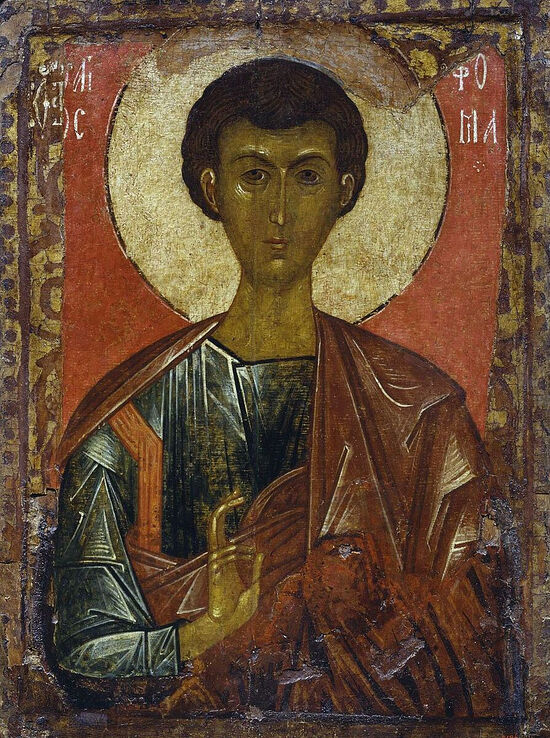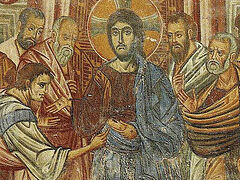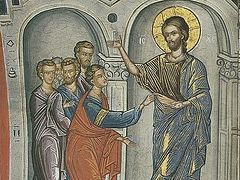The person of the Holy Apostle Thomas is challenging for many to comprehend. Or, perhaps not his person—indeed, amongst the whole host of the Apostles he is perhaps the most “relatable”, given that we know more of some of his weaknesses than we do of others—but rather, the comprehension of his place in the sacred memory of the Church. Every year it strikes many as peculiar that immediately after the week of the Passion, then Pascha and the joy and radiance of Bright Week, during which we confess the heart of our faith, the glorious Resurrection of the Savior of the world, that the first Sunday of that new season of resurrection is dedicated to St. Thomas’s doubt and unbelief. How different it seems from the sure and certain confession that resounds in Christian ears over the days that precede it, and indeed continues even in the midst of such a commemoration: “Christ is risen! Truly, He is risen!” And yet, a mere week after the greatest of all Feasts, it is doubt, unbelief, that we hear about over and again—in the Scriptural account, and especially hymns of that day. And when we come again to keep his memory in October (St. Thomas’ personal feast day is October 6/19), it is again his “disbelief” that is called to mind, both in the troparion dedicated to him, and in the Scripture: St. Thomas doubted, we are reminded, when told of the Lord’s rising from the tomb. He went so far as to say, in words that shake the hearts of believers, Except I shall put my finger into the print of the nails … I will not believe (John 20:25).
“Will not”. These are strong words! And yet, in the hymns this is referred to as the “good unbelief” of St. Thomas, and perhaps it is precisely this phrase that strikes some as the most odd, and most incomprehensible, of all. What can “good unbelief” mean? Surely, unbelief is the antithesis of belief, doubt is the opposite of faith; and even the Savior says that those who seek signs to confirm their belief are emblematic of a wicked and adulterous generation (Matthew 16:14). How then do we laud the disbelief of a man who demanded to see the very signs, the “proofs”, of resurrection?
The testimony of St. Thomas is so central to Christian life because, in precisely this question, he bears witness to a truth of comfort to every generation. In his person, in the language by which the Church remembers him, is disclosed an essential reality: that there are different kinds of “doubt” encountered in this life, and not each is subject to the same simplistic analysis that is often assumed—namely, that all doubt is the necessary opposite of belief. There is, yes, a worldly doubt that leads away from God, and it is in fact of this that we most often think when we hear the word, for it is the most familiar to our fallen culture. This kind of doubt is an expression of mistrust; it says to the soul, “I know better than what others may say, or what eyes may see, and I cannot, will not, believe that which exceeds the limits of my comprehension.” Such doubt is the fruit of the all-too-common tendency to place our own intellect above the revelation of God—to say “no” to the proclamation of that which might exist beyond, or buried deeper within, the heart than our intellect might be able to analyze, and ultimately to trust more in the intellect than in the revelation. It is a symptom of a lack of faith, and a proclamation of self-sufficiency, since it is at one and the same time a determination that one’s own understanding is greater than the realities put before it, and that those things that we do not understand are not to be believed. And for this very reason, this doubt often responds to the “proofs” it demands with yet more doubt, more denial. Even the proofs are subject to the authority of the intellect, the will, and man’s broken understanding. This is a doubt that makes the heart cold. A doubt that kills.
But this is not St. Thomas’s doubt. We encounter in him something very different: His is a questioning that is rooted in faith and the desire for faith to be secure—not grounded in hearsay or conjecture, but in reality. St.Thomas wants deeply to believe what his fellow Apostles have told him; but he doesn’t want his belief to be groundless. He wants the resurrection to be true. He wants Christ to be risen. And yet he doesn’t want to live a lie or base his heart’s hope in a falsehood or myth. And so he demands a security for his faith.
Because this is his good intention, the Lord condescends to him. Christ Himself shows Thomas His hands and His side. What the Apostle asks, the Lord grants—for the Lord knows his heart and his genuine desire. This is not altogether dissimilar to the Theotokos "good question”’ of the Archangel at the Annunciation, that her own faith might be secure. When she asked, “How can these things be?” (cf. Luke 1:34) her words were not a manifestation of weakness or rejection of the angelic message; rather, they were the voice of a heart seeking Truth above all. Where Eve had accepted the serpent’s words without questioning, the New Eve speaks to the Archangel. She questions. She longs to believe, and wants to be certain that she believes only what is true, that she may be drawn closer to Truth Himself.
In the case of St. Thomas, his probing questioning is not the fruit of a heart seeking to turn away from, or to set itself above, the revelation of Christ’s resurrection; it is the manner in which a man, acknowledging his own intellectual weakness, seeks to make his comprehension sure and strong. His disbelief is “good”, in the language of the Church’s hymns, precisely because it draws him towards God, rather than push him away. And so, truly, it did—this “doubting Thomas”, as the world knows him, went on to proclaim the Gospel in India, in Mesopotamia, in Ethiopia and various other corners of the world. His “disbelief” led him not to a denial of Christ, but to a martyr’s perfect confession. He who thrust his hand into the side of his Savior, feeling the mark where He was pierced by the spear, was himself pierced by five spears in glorious confession of the Resurrection, to which his own questioning had led him.
In such examples, the Christian learns that not all questioning, not all “doubt”, is the same—and so this must be applied to our own lives. We must flee from worldly doubt that breeds selfish intellectual isolation; but we must not fear the kinds of questions that are built from a desire to believe, and which might lead us to believe more firmly. We must shun that spirit which questions God in order to turn away from Him, seeking consolation in ourselves or in the world; but we must be willing to embrace the questions that leads us towards Him, and into His Kingdom. And this may lead us to say with no doubt whatever, that which St. Thomas was at last able to proclaim with all his heart, “Christ is risen!”




